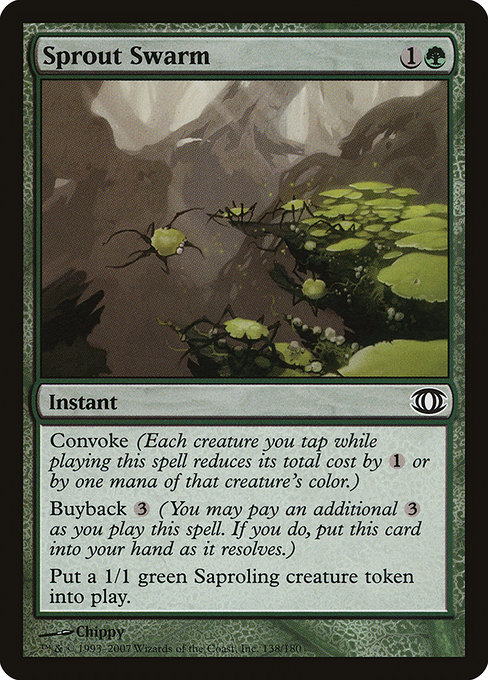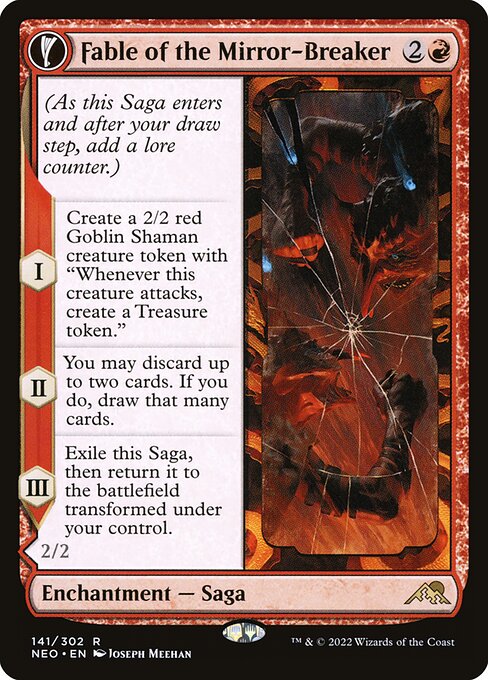When Magic’s final history is written, one of the more interesting chapters will deal with the printing of Modern Horizons and the injection of freshly-printed cards into an existing format that previously only received new cards once they’d passed through the conduit of a Standard set. It was a new revenue stream, a way to revisit dead characters or vanished worlds, and a controversial way to alter the Modern metagame.
Modern Horizons 1 and 2 brought with them design freedom for Wizards of the Coast: because the price point and branding of the Horizons sets inherently limit the audience, they can assume that players interested in the sets have basic familiarity with past mechanics and advanced interactions within Magic. Thus, they could design more complex, self-referential cards. As an avid fan of Time Spiral Block, Lorwyn Limited, and a Cube dilettante, I was a fan, but it did feel like a watershed moment for Magic design.
With the embrace (or takeover, depending on your point of view) of EDH back in 2011, the introduction of eight-, ten-, twelve-, and twenty-sided dice into black-bordered Magic, and the creation of digital-only cards with the advent of Arena, it’s now basically impossible to guarantee what your cards do or to retain even a fraction of the cards printed. At the same time, cards are getting wordier–or at least, they were by 2020. At one point, Magic strove for elegance in every card. I recognize that you can’t capture Lightning Bolt in a bottle in every set, but let’s just say I’m very glad that the Strixhaven Deans got compleated.
There is still elegance to be found, though, even in a world of transforming Battles and battling Transformers and Compleated Tamiyos and “create a token that’s a copy of this Planeswalker.” I define elegance in Magic as an individual card design that:
- Conveys information concisely and understandably with a minimum of extraneous information (that is, has a high signal-to-noise ratio), and
- Has a minimum amount of hidden rules text.
Hidden rules text is a concept where reading the card doesn’t fully explain the card. I’m not talking about reminder text, which has a tendency to disappear on higher-rarity cards, although that can be an issue, but card types like Battles and Planeswalkers and Tribal, where there are tacit rules to how they operate that aren’t laid out on the card. You could make the argument that every card has hidden rules text–every card, that is, save the full-text lands–but some are more rules-heavy than others, and thus tend to be less elegant.
To provide a more metaphysical definition, elegant card design is card design that would be understandable to a player in 1998 or 2038. Void Rend, for example, would have been printable in Invasion or Spacefarers of Kamigawa. Goblin Guide could have shown up right next to Savannah Lions back in ‘93, because it’s elegant–everything the card can do is written directly on it and only uses game actions that have existed since the start.
I would also note that “wordy” is not the same thing as “inelegant”—there can be a kind of elegance in maximalism, too, from the Swiss Army knife comedy of Questing Beast to the infernally bureaucratic flavor of Chains of Mephistopheles. Fable of the Mirror-Breaker has more text than Odric, Blood-Cursed, but it tells a story, it progresses naturally through its chapters and thus is easier to recall in play.
The cards Wizards has printed recently are prolix for prolixity’s sake, all niche-case Commanders and “if you do this, then this triggers” operating language puzzles. We left Magic’s Takklemaggot and Ice Cauldrons in the past for a reason, and yet I’m taken aback when I accidentally start an Alchemy-legal game on Arena and am confronted with a multifaceted card that scrolls out into an entire hand’s worth of possible faces or when I pick up a friend’s Commander to read it for the fifth time in a game.
Inelegant cards are an important part of Magic–not every card can be Yargle and Multani, and certainly Urabrask sells packs. Sometimes clunkiness is worth the cost, too–Ikoria’s Mutate is a difficult, wordy mechanic, but Wizards made the call that it was cool and flavorful enough to balance any frustration and confusion. Sometimes, opacity can intrigue a player base, rather than alienate them. Anyone who recalls their early days playing Magic has a story where they found some massive Kraken or gnarly transform Werewolf or nine-mana enchantment, all larded with text and just waiting to reveal Magic’s vistas to a neophyte. But my point is that Magic, as it grows more complex under its own rules structures and produces thousands of cards each year to satisfy shareholders, not artists, still has techniques it can rely upon to drive excitement without crossing a threshold of wordiness.
One such technique is the Modern Horizons “mix-and-match” keyword mélange, which benefits enfranchised players and allows for surprising mashups. Cycling plus Unearth (Viscera Dragger) was a minor revelation when it was printed in Shards of Alara—while a simple card (without reminder text, the entire text box is two words) Viscera Dragger tested decision-making skills at high levels of play and smoothed the often-jagged mana curves of the three-to-five-color Limited decks of that era—and led to the Eternalize plus Plainscycling combo of Timeless Dragon.

Earlier this week, a friend was shuffling through my Cube, whose thesis is “I would be happy to first pick any of these cards,” and chuckled “Sprout Swarm?” as he went for the Umezawa’s Jitte or Ethereal Absolution or Thrun, Breaker of Silence. Sprout Swarm, indeed. An unassuming card, the Swarm, once you hit a critical mass of Saprolings, lets you build an inevitable army. The first time, you pay 4G for a 1/1—an awful deal, but when it doesn’t cost you a card and can be done at instant speed, you’d be amazed how quickly this gets out of hand. Buyback makes almost any effect menacing, from Whispers of the Muse breaking control mirrors to Evincar’s Justice dominating Pauper for a time. Pumping out a chump blocker for 4G isn’t powerful, but when those chumps can breed other chumps through Convoke, you find yourself with a surprising Limited day-ruiner. The card reads like a 23rd pick and plays like a bomb, all because it mashes up two keywords with blatant but low-key synergy, and you end up with another elegant two-word text box. Magic is still capable of throwing us curveballs, even after three decades—cards like Bonded Fetch or Izzet Staticaster present a minimal but intriguing puzzle, while cards like Thrasta, the Tempest’s Roar ask us to evaluate an optimal version and then engineer that situation within the game.
Another model of elegance is the recent-ish trend in Magic language of making the creature the actual actor in a sentence. “It explores,” “each creature that convoked this spell connives,” “it becomes monstrous,” etc.—these are powerfully resonant phrases that make the creatures we summon more active participants in a game. There’s a reason “summoning sickness” has stuck around, not just as flavor, but as actual language in reminder text and “this land continues to burn” (Obsidan Fireheart) has not. In Magic, our creatures “gain” and “lose” abilities, they take action, they suffer from summoning sickness or the trauma of [/mtg_card]Torture[/mtg_card]. It’s plausible that Modern Horizons 3 (or 4, depending on how you categorize Tales of Middle-earth) could include a resourceful explorer creature with the text “when [this] enters the battlefield, it explores, then it connives” thus fuses these two models of elegance, but even if not, the use of “it explores” rather than “you explore” turns creatures from pawns to people. Simple game actions that become a pact between player and creature—that’s elegance. We like when our creatures have agency, from Lord of the Pit extracting his tribute to Raffine plotting each turn, honing our hand and getting better in combat.
Magic’s great advantage is that it’s flexible and can adapt to players’ desires. Some players love Portal-style simplicity, while others are exhilarated by the fractalized possibilities of Alchemy, with its various six-sided cards and randomized outcomes. Some players are drawn to expressing themselves by building outré Commander decks, others want to see how reliably and quickly they can assemble a combo. Some players play black-bordered Old School, some players play Megatron in their Jeffrey Dean Morgan Commander deck. Here’s the core issue: Magic has to be at least feasibly attractive to all of those players while printing more cards than ever before and designing for more formats than ever before.
Twenty years ago, Magic was Standard, Limited, Extended, Legacy, and Vintage, with 4-of casual and mutant formats picking up the table scraps. Now, Wizards has to design for Commander, Limited, Standard, Pioneer, Modern, Historic, Alchemy, and Brawl and design cards for best-of-one formats on Arena instead of the once-standard best-of-three matches. They have to balance that with printing cards enticing enough to get players to buy packs and boxes of the latest set and crafting Limited and Constructed environments attractive to both newer players and tournament grinders (who are actively engaged in trying to disrupt those environments to their benefit). All of which is to say that I’m not intending to critique Wizards for inelegance in Magic design–I truly believe that, aesthetically, the game has never been in better shape, which can paper over a fair bit of clunkiness.

Since 2020, Wizards has printed a handful of cards that I consider among my favorites of all time–Graveyard Trespasser, Fable of the Mirror-Breaker, Sheoldred, the Apocalypse, Boseiju, Who Endures, Valki, God of Lies–and has weathered a global pandemic and massive shifts in the game’s economy. There are a number of valid critiques to be made of Magic in 2023 and I think some valid concerns about potential outcomes of Hasbro’s governance and product release strategies–not to mention the fact that Disney’s Lorcana is waiting in the wings to siphon off a portion of Magic’s audience–but so long as the card backs have that pentagram of colors, there’s a simplicity and elegance to Magic. You can graft as much onto the skeleton of Magic as you want, but eventually, all that rots away and those graceful bones show through.
Rob Bockman (he/him) is a native of South Carolina who has been playing Magic: the Gathering since Tempest block. A writer of fiction and stage plays, he loves the emergent comedy of Magic and the drama of high-level play. He’s been a Golgari player since before that had a name and is never happier than when he’s able to say “Overgrown Tomb into Thoughtseize,” no matter the format.

